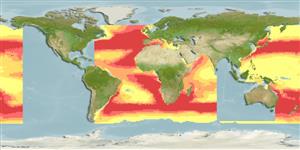Actinopterygii (ray-finned fishes) >
Myctophiformes (Lanternfishes) >
Myctophidae (Lanternfishes) > Lampanyctinae
Etymology: Diaphus: Greek, dis, dia = through + Greek, physa, phyo = to beget, to have as offspring (Ref. 45335).
Environment / Climate / Range
Ecology
Marine; bathypelagic; non-migratory; depth range 90 - 1085 m (Ref. 56504). Deep-water, preferred ?; 60°N - 58°S, 67°W - 153°W
Eastern Atlantic: British Isles to Mauritania including western Mediterranean, but isolated specimens to Liberia and South Africa. Western Atlantic: USA to 22°N, and from Brazil to Argentina. Western Indian Ocean: between 0° and 30°S. Western Pacific: between 6°N and 39°N, New South Wales, Australia (Ref. 7300) and New Zealand (Ref. 5755).
Length at first maturity / Size / Weight / Age
Maturity: Lm ?, range 5 - ? cm
Max length : 7.5 cm SL male/unsexed; (Ref. 4479)
Oceanic and mesopelagic, found between 375-850 m during the day and between 90-850 m at night (Ref. 4066). Benthopelagic (Ref. 58302). Depth range from 518-1085 m in the eastern Ionian Sea (Ref. 56504). Reach sexual maturity at a length of 4,8 cm (Ref. 47377).
Life cycle and mating behavior
Maturity | Reproduction | Spawning | Eggs | Fecundity | Larvae
Hulley, P.A., 1990. Myctophidae. p. 398-467. In J.C. Quero, J.C. Hureau, C. Karrer, A. Post and L. Saldanha (eds.) Check-list of the fishes of the eastern tropical Atlantic (CLOFETA). JNICT, Lisbon; SEI; Paris; and UNESCO, Paris. Vol. 1. (Ref. 4479)
IUCN Red List Status (Ref. 115185)
CITES (Ref. 94142)
Not Evaluated
Threat to humans
Harmless
Human uses
More information
ReferencesAquacultureAquaculture profileStrainsGeneticsAllele frequenciesHeritabilityDiseasesProcessingMass conversion
Tools
Special reports
Download XML
Internet sources
